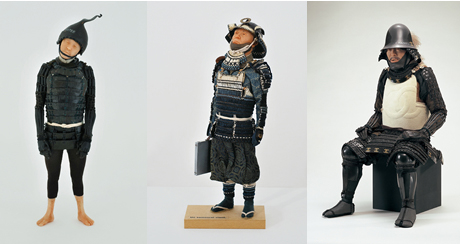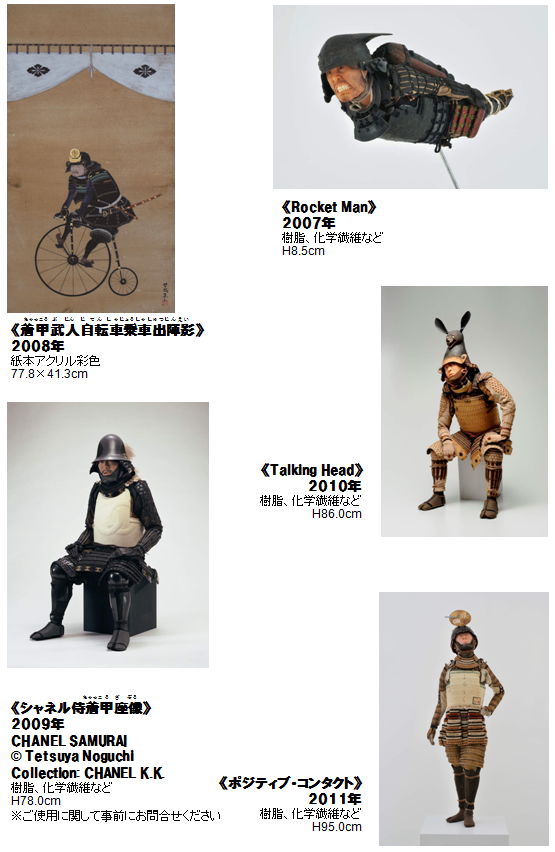
The Asahi Beer Oyamazaki Villa Museum of Art is located in Yamazaki, a place of historical significance in Japan since medieval times when it served as a field of battle for Toyotomi Hideyoshi to avenge the betrayal and murder of his lord Oda Nobuaga. The museum is currently hosting an exhibition that pays homage to the samurai of those ancient times, in a very modern and surreal fashion.
Yamazaki in current-day Kyoto is famous for the Battle of Yamazaki, the conflict that arose in 1582 after warlord Oda Nobunaga was forced to commit seppuku by one of his retainers, Akechi Mitsuhide.
After hearing news of Nobunaga’s death, Toyotomi Hideyoshi marched from Takamatsu Castle towards Kyoto to avenge his fallen lord. Sandwiched between Tennozan Hill and Yodogawa River, Yamazaki was known as the final ‘gate’ on the road leading up from Osaka to Kyoto, and this is where Mitsuhide made his stand. However, Hideyoshi’s forces soon defeated him, and he would go on to take over Nobunaga’s position and succeed in bringing an end to the era of warring states and uniting Japan.
With such a famous and serious historical legacy, you’d expect such a place to have a special reverence for samurai, and so it comes as no surprise to hear of a samurai art show being held at the museum. However, when you take a closer look at these warrior statues, you’ll find that there’s something a little…off about them.
The title of said exhibition is ‘Tetsuya Noguchi’s Illustrated Guide to Samurai Classifications’. Noguchi is an artist who uses resin and plasticine to create armored samurai that bring to life his own unique worldview. His subtle humour is reflected in the worldplay in the title of the exhibition: the Japanese the word for ‘samurai classifications’ is read as ‘mushabunrui‘, which is similar to ‘mushaburui‘, the word for ‘trembling with excitement’.
This weird display of samurai includes the ‘Chanel Samurai’, who at first glance appears completely normal until you notice that his white chest plate is emblazoned with the famous Chanel brand logo. There’s also ‘Rocket Man’ blasting through the air with a jet pack, ‘Talking Head’ who sports some kind of bizarre rabbit-like creature as a hat, and ‘Positive Contact’, who appears to have a receiver attached to his helm. As well as figures, Noguchi is also adept at painting, as seen with his surreal depiction in acrylics of a samurai riding out to battle on a penny farthing.
His extremely modern take on samurai may be considered trite by some, but others will see them as true works of art. On the one hand they’re clearly a joke, but on the other they’re very detailed and realistic looking figures caught in life-like poses, and as such his interpretations may help us to feel a common affinity with these historical figures.
If you have the chance to visit the museum, you should also drop by the cafe which will be offering three special cakes in collaboration with the Kyoto Rihga Royal Hotel during the course of the exhibition. Two of them sound delicious: ‘green tea and yuzu’ and ‘cinnamon, dark chocolate, and dried mango’. Then, in keeping with the bizarre art, we also get a combination of orange and…charcoal bamboo?! The taste is described as ‘refreshing’, which may be a euphemism for ‘terrible’, but it seems like the most fitting thing to finish with after the rabbit hole journey into Noguchi’s imagination.
Source: Japaaan Magazine
Images: Asahi Beer Oyamazaki Villa Museum of Art




 Katana coasters! Samurai sword tableware brings bushido to your home
Katana coasters! Samurai sword tableware brings bushido to your home Hugh Jackman stars, sings J-pop cover, and speaks Japanese in ads for Toyota【Videos】
Hugh Jackman stars, sings J-pop cover, and speaks Japanese in ads for Toyota【Videos】 Legendary crescent moon katana, one of Japan’s Five Swords Under Heaven, now on display in Tokyo
Legendary crescent moon katana, one of Japan’s Five Swords Under Heaven, now on display in Tokyo This Valentine’s Day, wow your special someone with boozy samurai warlord chocolates!
This Valentine’s Day, wow your special someone with boozy samurai warlord chocolates! Swords of famous samurai reborn as beautiful kitchen knives from Japan’s number-one katana town
Swords of famous samurai reborn as beautiful kitchen knives from Japan’s number-one katana town Japanese ramen restaurants under pressure from new yen banknotes
Japanese ramen restaurants under pressure from new yen banknotes Sakura tree falls on man at Sannenzaka near Kiyomizu temple in Kyoto 【Breaking News】
Sakura tree falls on man at Sannenzaka near Kiyomizu temple in Kyoto 【Breaking News】 We tried Korea’s way-too-big King Tonkatsu Burger at Lotteria 【Taste Test】
We tried Korea’s way-too-big King Tonkatsu Burger at Lotteria 【Taste Test】 McDonald’s new Happy Meals offer up cute and practical Sanrio lifestyle goods
McDonald’s new Happy Meals offer up cute and practical Sanrio lifestyle goods Secret Kitchen bento serves Japanese flowers, birds, wind and moon in a box, but is it worth it?
Secret Kitchen bento serves Japanese flowers, birds, wind and moon in a box, but is it worth it? Tokyo Tsukiji fish market site to be redeveloped with 50,000-seat stadium, hotel, shopping center
Tokyo Tsukiji fish market site to be redeveloped with 50,000-seat stadium, hotel, shopping center Mt. Koya planning to instate visitor’s tax to cope with huge tourist numbers
Mt. Koya planning to instate visitor’s tax to cope with huge tourist numbers Beautiful Ghibli sealing wax kits let you create accessories and elegant letter decorations【Pics】
Beautiful Ghibli sealing wax kits let you create accessories and elegant letter decorations【Pics】 Beautiful Red and Blue Star luxury trains set to be Japan’s new Hokkaido travel stars
Beautiful Red and Blue Star luxury trains set to be Japan’s new Hokkaido travel stars French Fries Bread in Tokyo’s Shibuya becomes a hit on social media
French Fries Bread in Tokyo’s Shibuya becomes a hit on social media All-you-can-drink Starbucks and amazing views part of Tokyo’s new 170 meter-high sky lounge
All-you-can-drink Starbucks and amazing views part of Tokyo’s new 170 meter-high sky lounge More foreign tourists than ever before in history visited Japan last month
More foreign tourists than ever before in history visited Japan last month Starbucks reopens at Shibuya Scramble Crossing with new look and design concept
Starbucks reopens at Shibuya Scramble Crossing with new look and design concept Studio Ghibli releases new action figures featuring Nausicaä of the Valley of the Wind characters
Studio Ghibli releases new action figures featuring Nausicaä of the Valley of the Wind characters Studio Ghibli glasses cases let anime characters keep an eye on your spectacles
Studio Ghibli glasses cases let anime characters keep an eye on your spectacles Is the new Shinkansen Train Desk ticket worth it?
Is the new Shinkansen Train Desk ticket worth it? New private rooms on Tokaido Shinkansen change the way we travel from Tokyo to Kyoto
New private rooms on Tokaido Shinkansen change the way we travel from Tokyo to Kyoto Studio Ghibli releases Kiki’s Delivery Service chocolate cake pouches in Japan
Studio Ghibli releases Kiki’s Delivery Service chocolate cake pouches in Japan New definition of “Japanese whiskey” goes into effect to prevent fakes from fooling overseas buyers
New definition of “Japanese whiskey” goes into effect to prevent fakes from fooling overseas buyers Our Japanese reporter visits Costco in the U.S., finds super American and very Japanese things
Our Japanese reporter visits Costco in the U.S., finds super American and very Japanese things Studio Ghibli unveils Mother’s Day gift set that captures the love in My Neighbour Totoro
Studio Ghibli unveils Mother’s Day gift set that captures the love in My Neighbour Totoro Domino’s Japan now sells…pizza ears?
Domino’s Japan now sells…pizza ears? New Japanese KitKat flavour stars Sanrio characters, including Hello Kitty
New Japanese KitKat flavour stars Sanrio characters, including Hello Kitty New Pokémon cakes let you eat your way through Pikachu and all the Eevee evolutions
New Pokémon cakes let you eat your way through Pikachu and all the Eevee evolutions Sales of Japan’s most convenient train ticket/shopping payment cards suspended indefinitely
Sales of Japan’s most convenient train ticket/shopping payment cards suspended indefinitely Sold-out Studio Ghibli desktop humidifiers are back so Totoro can help you through the dry season
Sold-out Studio Ghibli desktop humidifiers are back so Totoro can help you through the dry season Japanese government to make first change to romanization spelling rules since the 1950s
Japanese government to make first change to romanization spelling rules since the 1950s Ghibli founders Toshio Suzuki and Hayao Miyazaki contribute to Japanese whisky Totoro label design
Ghibli founders Toshio Suzuki and Hayao Miyazaki contribute to Japanese whisky Totoro label design Doraemon found buried at sea as scene from 1993 anime becomes real life【Photos】
Doraemon found buried at sea as scene from 1993 anime becomes real life【Photos】 Tokyo’s most famous Starbucks is closed
Tokyo’s most famous Starbucks is closed One Piece characters’ nationalities revealed, but fans have mixed opinions
One Piece characters’ nationalities revealed, but fans have mixed opinions We asked a Uniqlo employee what four things we should buy and their suggestions didn’t disappoint
We asked a Uniqlo employee what four things we should buy and their suggestions didn’t disappoint Princesses, fruits, and blacksmiths: Study reveals the 30 most unusual family names in Japan
Princesses, fruits, and blacksmiths: Study reveals the 30 most unusual family names in Japan Protect your drinks with Samurai armour bottle covers
Protect your drinks with Samurai armour bottle covers Even samurai ran late! Newly discovered document shows one warrior’s excuse to his boss
Even samurai ran late! Newly discovered document shows one warrior’s excuse to his boss A roundup of some of this year’s best “Samurai Sanders”: KFC’s mascot in samurai armor【Photos】
A roundup of some of this year’s best “Samurai Sanders”: KFC’s mascot in samurai armor【Photos】 Dojigiri, the millennium-old katana said to have slain a demon, is now on display in Tokyo【Pics】
Dojigiri, the millennium-old katana said to have slain a demon, is now on display in Tokyo【Pics】 Pikachu and Kyoto candy maker team up for confectionary collaboration centuries in the making
Pikachu and Kyoto candy maker team up for confectionary collaboration centuries in the making Stay dry with Japan’s top 10 indoor attractions for rainy days, as voted by tourists
Stay dry with Japan’s top 10 indoor attractions for rainy days, as voted by tourists Starbucks celebrates 20 years in West Japan with Matcha Frappuccino and latte drinks in Osaka
Starbucks celebrates 20 years in West Japan with Matcha Frappuccino and latte drinks in Osaka Samurai Ninja Museum Tokyo With Experience is true to its name, lets you slice with real katana
Samurai Ninja Museum Tokyo With Experience is true to its name, lets you slice with real katana Samurai backpacks from Kyoto combine lamellar tradition, awesome style, and modern functionality
Samurai backpacks from Kyoto combine lamellar tradition, awesome style, and modern functionality Samurai Studio: Tokyo’s new photo studio where you can get your picture taken in samurai armor
Samurai Studio: Tokyo’s new photo studio where you can get your picture taken in samurai armor Mini samurai sword scissors are here to help you slice paper and plastic foes to pieces【Photos】
Mini samurai sword scissors are here to help you slice paper and plastic foes to pieces【Photos】 KFC’s Colonel Sanders is becoming a samurai in Japan this week
KFC’s Colonel Sanders is becoming a samurai in Japan this week We visit the awesome new Samurai Museum in Shinjuku【Photos】
We visit the awesome new Samurai Museum in Shinjuku【Photos】 There’s a touching reason it took so long for samurai and ninja to show up in One Piece
There’s a touching reason it took so long for samurai and ninja to show up in One Piece Emperors, anime icons, and porn stars show up in six-nation survey of most famous Japanese people
Emperors, anime icons, and porn stars show up in six-nation survey of most famous Japanese people
Leave a Reply